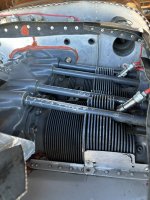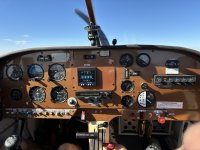Hey folks,
I just bought an RV6a and the CHTs are very hot. Engine is an O-360 carbureted. Are these following numbers normal?
These are the numbers if I do a cold start, and then taxi for <5 minutes to the run-up area and take off. If I do a hot start (such as a quick fuel stop), these numbers are ~25-50 degrees higher
The builder who I bought it from never does hot starts, so he did not have a problem with this. He essentially would do a very quick taxi, take off, then immediately reduce power in the climb. Even with a cold start, I am unable to climb more than 500fpm without having CHT's go above 450 (and would prefer to keep them under 400). When doing a hot start, I essentially have to cut power as soon as I rotate and climb at ~200fpm to keep the CHTs < 450.
The engines have these little metal plates in front. I heard that we could remove these or trim these to be smaller?
I just bought an RV6a and the CHTs are very hot. Engine is an O-360 carbureted. Are these following numbers normal?
These are the numbers if I do a cold start, and then taxi for <5 minutes to the run-up area and take off. If I do a hot start (such as a quick fuel stop), these numbers are ~25-50 degrees higher
| Airspeed & RPM | CHTs | OAT |
| Idle - 800 rpm | ~350 F | 80 F |
| At 100ft AGL after takeoff, 90 knots, 2500 rpm | ~450 F | 80 F |
| Enroute climb at 110kts, 2300rpm, 500fpm | 420-450 F | ~70 F |
| Cruise, 130kts IAS, 2200rpm, 10,500' MSL | ~390 - 400 F (I am used to seeing these temps when at full power, not 60% power) | ~60 F |
The builder who I bought it from never does hot starts, so he did not have a problem with this. He essentially would do a very quick taxi, take off, then immediately reduce power in the climb. Even with a cold start, I am unable to climb more than 500fpm without having CHT's go above 450 (and would prefer to keep them under 400). When doing a hot start, I essentially have to cut power as soon as I rotate and climb at ~200fpm to keep the CHTs < 450.
The engines have these little metal plates in front. I heard that we could remove these or trim these to be smaller?







